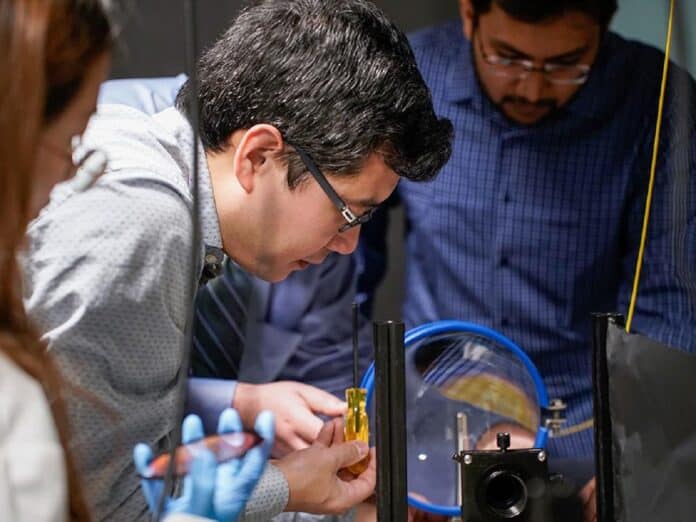Astronomers and amateur astronomers alike understand that the larger the telescope, the more powerful the imaging capabilities. A Penn State-led research team developed the world’s first ultrathin, compact metalens telescope capable of photographing distant objects like the moon.
Metalenses are made of microscopic, antenna-like surface patterns that can focus light on magnifying distant objects in the same way as typical curved glass lenses can, but they are flat. Whereas tiny, millimeter-wide metalenses had previously been constructed, the researchers increased the size of the lens to eight centimeters in diameter, or roughly four inches wide, allowing it to be used in large optical systems like telescopes.
Corresponding author Xingjie Ni, associate professor of electrical engineering and computer science at Penn State, said, “Traditional camera or telescope lenses have a curved surface of varying thickness, where you have a bump in the middle and thinner edges, which causes the lens to be bulky and heavy. Metalenses use nano-structures on the lens instead of curvature to contour light, which allows them to lay flat.”
According to Ni, this is one of the reasons current cell phone camera lenses protrude from the phone’s body: the thickness of the lenses takes up space, even if they seem flat since they are covered behind a glass pane.
Metalenses are often created by electron beam lithography, which involves scanning a focussed beam of electrons over a piece of glass or another transparent substrate to form antenna-like patterns point by point. The scanning procedure of the electron beam, on the other hand, restricts the size of the lens that can be constructed since scanning each point takes time and has poor throughput.
The researchers used a production technology known as deep ultraviolet (DUV) photolithography, frequently used to build computer chips, to construct a larger lens.
Ni said. “DUV photolithography is a high-throughput and high-yield process that can produce many computer chips within seconds. We found this a good fabrication method for metalenses because it allows for much larger pattern sizes while maintaining small details, allowing the lens to work effectively.”
The researchers improved the process by devising their rotating wafer and stitching procedure. The wafer on which the metalens was separated into four quadrants, which were then divided into 22 by 22-millimeter sections – smaller than a conventional postage stamp. They utilized DUV lithography to project a design onto four quadrants, rotating 90 degrees and repeating until all four were patterned.
He also said, “The process is cost-effective because the masks containing the pattern data for each quadrant can be reused due to the rotation symmetry of the metalens. This reduces the manufacturing and environmental costs of the method.”
The digital files necessary to produce the patterns became much more significant as the size of the metalens rose, which would take a long time for the DUV lithography machine to process. The researchers compress the files by referencing non-unique data and using data approximations to address this issue.
A scientist said, “We utilized every possible method to reduce the file size. We identified identical data points and referenced existing ones, gradually reducing the data until we had a usable file to send to the machine for creating the metalens.”
The researchers created a single-lens telescope using novel production technology. They captured clear photos of the lunar surface, achieving higher object resolution and a greater imaging distance than earlier metalenses. But, before the technique can be used in current cameras, researchers must address the issue of chromatic aberration, which produces image distortion and blurriness when various colors of light enters a lens and bend in different directions.
He said, “We are exploring smaller and more sophisticated designs in the visible range and will compensate for various optical aberrations, including chromatic aberration,”
Coauthors include Lidan Zhang, Shengyuan Chang, Xi Chen, Yimin Ding, Md Tarek Rahman, and Yao Duan, all current or past Penn State electrical engineering graduate students. Mark Stephen of NASA’s Goddard Space Flight Center also contributed.
This research was funded by the NASA Early Career Faculty Grant, the US Office of Naval Research, and the National Science Foundation.
Journal Reference:
- Lidan Zhang, Xi Chen, et al. High-Efficiency, 80 mm Aperture Metalens Telescope. NanoLett. DOI: 10.1021/acs.nanolett.2c03561
